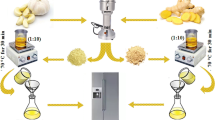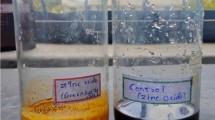Abstract
Nanoparticles fabricated with biological reducing agents to minimize toxic effects of chemicals are being focused worldwide. Biologically synthesized metal oxide nanomaterials have become integral part of nanotechnology. The current work is providing an insight on ZnO nanoparticles having root extract of Z. officinale and A. sativum in terms of catalytic and antimicrobial action potential. The synthesized nanoparticles were characterized by X-ray Diffraction (XRD), Fourier-Transform Infrared Spectroscopy (FTIR), X-ray Photoelectron Spectroscopy (XPS), Ultra-Violet visible spectroscopy (UV–vis), Scanning Electron Microscopy (SEM), Transmission Electron Microscopy (TEM) and Energy-Dispersive X-ray Spectroscopy (EDS) analysis. The synthesized nanoparticles showed strong absorption at 365 nm with size range between 31.64 and 44 nm for Z. officinale and 28–45 nm in case of A. sativum-doped ZnO as revealed by UV–vis and XRD. The Z. officinale-doped nanoparticles demonstrated enhanced antibacterial activity against multiple drug-resistant S. aureus at increasing concentrations (0.5, 1.0 mg/50 µl) and also actively degraded methylene blue (MB) dye. ZnO nanoparticles synthesized by green approach have potential to resolve emerging drug resistance against pathogenic bacterial diseases. Conclusively, significant inhibition zones resulted against (MDR) S. aureus ranging 1.80–2.25 mm and 2.3–3 mm at low and high concentrations for Z. officinale while, 1.7–2.05 mm and 2.2–2.7 mm for A. sativum-doped ZnO-NPs.










Similar content being viewed by others
References
Banerjee S, Mullick H, Banerjee J, Ghosh A (2011) Zingiber officinale:‘a natural gold’. Int J Pharm Bio-Sci 2:283–294
Bhandari PR (2012) Garlic (Allium sativum L.): A review of potential therapeutic applications. Int J Green Pharm (IJGP) 6(2):118–129
Bigdeli F, Morsali A, Retailleau P (2010) Syntheses and characterization of different zinc (II) oxide nano-structures from direct thermal decomposition of 1D coordination polymers. Polyhedron 29(2):801–806
Chastain J (1992) Handbook of X-ray photoelectron spectroscopy, vol 40. Perkin-Elmer Corporation, USA
Das J, Pradhan S, Sahu D, Mishra D, Sarangi S, Nayak B, Verma S, Roul B (2010) Micro-Raman and XPS studies of pure ZnO ceramics. Phys B 405(10):2492–2497
Das RK, Gogoi N, Bora U (2011) Green synthesis of gold nanoparticles using Nyctanthes arbortristis flower extract. Bioprocess Biosyst Eng 34(5):615–619
Dodd F (1983) Mastitis—progress on control. J Dairy Sci 66(8):1773–1780
El-Refai AA, Ghoniem GA, El-Khateeb AY, Hassaan MM (2018) Eco-friendly synthesis of metal nanoparticles using ginger and garlic extracts as biocompatible novel antioxidant and antimicrobial agents. J Nanostruct Chem 8(1):71–81
Endres J, Egger DA, Kulbak M, Kerner RA, Zhao L, Silver SH, Hodes G, Rand BP, Cahen D, Kronik L (2016) Valence and conduction band densities of states of metal halide perovskites: a combined experimental–theoretical study. J Phys Chem Lett 7(14):2722–2729
Hawkey P (2008) The growing burden of antimicrobial resistance. J Antimicrob Chemother 62(1):1–9
Hernawan UE, Setyawan AD (2003) Organosulphure compound of garlic (Allium sativum L.) and its biological activities. Biofarmasi J Nat Prod Biochem 1(2):65–76
Hinckley L, Benson R, Post J (1987) How management affects the control of Staphylococcal mastitis. Veterinary Medicine, USA
Hosseinkhani P, Zand A, Imani S, Rezayi M, Rezaei Zarchi S (2011) Determining the antibacterial effect of ZnO nanoparticle against the pathogenic bacterium, Shigella dysenteriae (type 1). Int J Nano Dimens 1(4):279–285
Indana MK, Gangapuram BR, Dadigala R, Bandi R, Guttena V (2016) A novel green synthesis and characterization of silver nanoparticles using gum tragacanth and evaluation of their potential catalytic reduction activities with methylene blue and Congo red dyes. J Anal Sci Technol 7(1):19
Iwalokun B, Ogunledun A, Ogbolu D, Bamiro S, Jimi-Omojola J (2004) In vitro antimicrobial properties of aqueous garlic extract against multidrug-resistant bacteria and Candida species from Nigeria. J Med Food 7(3):327–333
Jacob S, Bharathkumar R, Ashwathram G (2014) Aspergillus niger mediated synthesis of ZnO nanoparticles and their antimicrobial and in vitro anticancerous activity. World J Pharm Res. 3(2):3044–3054
Jain D, Daima HK, Kachhwaha S, Kothari S (2009) Synthesis of plant-mediated silver nanoparticles using papaya fruit extract and evaluation of their anti microbial activities. Dig J Nanomater Biostruct 4(3):557–563
Janaki AC, Sailatha E, Gunasekaran S (2015) Synthesis, characteristics and antimicrobial activity of ZnO nanoparticles. Spectrochim Acta Part A Mol Biomol Spectrosc 144:17–22
Leonard K, Ahmmad B, Okamura H, Kurawaki J (2011) In situ green synthesis of biocompatible ginseng capped gold nanoparticles with remarkable stability. Colloids Surf B 82(2):391–396
Manna J, Begum G, Kumar KP, Misra S, Rana RK (2013) Enabling antibacterial coating via bioinspired mineralization of nanostructured ZnO on fabrics under mild conditions. ACS Appl Mater Interfaces 5(10):4457–4463
Nagarajan S, Kuppusamy KA (2013) Extracellular synthesis of zinc oxide nanoparticle using seaweeds of gulf of Mannar, India. J Nanobiotechnol 11(1):39
Radostits OM, Gay CC, Hinchcliff KW, Constable PD (2006) Veterinary Medicine E-Book: A textbook of the diseases of cattle, horses, sheep, pigs and goats. Elsevier Health Sciences, USA
Rafiq A, Imran M, Ikram M, Naz M, Aqeel M, Majeed H, Hussain SG, Ali S (2019) Photocatalytic and catalytic degradation of organic dye by uncapped and capped ZnS quantum dots. Mater Re Express 6(5):055801
Salam HA, Sivaraj R, Venckatesh R (2014) Green synthesis and characterization of zinc oxide nanoparticles from Ocimum basilicum L. var. purpurascens Benth.-Lamiaceae leaf extract. Mater Lett 131:16–18
Sawai J (2003) Quantitative evaluation of antibacterial activities of metallic oxide powders (ZnO, MgO and CaO) by conductimetric assay. J Microbiol Methods 54(2):177–182
Selvarajan E, Mohanasrinivasan V (2013) Biosynthesis and characterization of ZnO nanoparticles using Lactobacillus plantarum VITES07. Mater Lett 112:180–182
Senthilkumar S, Sivakumar T (2014) Green tea (Camellia sinensis) mediated synthesis of zinc oxide (ZnO) nanoparticles and studies on their antimicrobial activities. Int J Pharm Pharm Sci 6(6):461–465
Shankar SS, Rai A, Ahmad A, Sastry M (2004) Rapid synthesis of Au, Ag, and bimetallic Au core—Ag shell nanoparticles using Neem (Azadirachta indica) leaf broth. J Colloid Interface Sci 275(2):496–502
Song N, Fan H, Tian H (2015) Reduced graphene oxide/ZnO nanohybrids: metallic Zn powder induced one-step synthesis for enhanced photocurrent and photocatalytic response. Appl Surf Sci 353:580–587
Sunada K, Kikuchi Y, Hashimoto K, Fujishima A (1998) Bactericidal and detoxification effects of TiO2 thin film photocatalysts. Environ Sci Technol 32(5):726–728
Tsiaganis MC, Laskari K, Melissari E (2006) Fatty acid composition of Allium species lipids. J Food Compos Anal 19(6–7):620–627
Yan L, Zheng YB, Zhao F, Li S, Gao X, Xu B, Weiss PS, Zhao Y (2012) Chemistry and physics of a single atomic layer: strategies and challenges for functionalization of graphene and graphene-based materials. Chem Soc Rev 41(1):97–114
Yedurkar S, Maurya C, Mahanwar P (2016) Biosynthesis of zinc oxide nanoparticles using ixora coccinea leaf extract—a green approach. Open J Synth Theory Appl 5(01):1
Zelechowska K (2014) Methods of ZnO nanoparticles synthesis. BioTechnologia. J Biotechnol Comput Biol Bionanotechnol 95(2):150–159
Zheng J, Jiang Q, Lian J (2011) Synthesis and optical properties of flower-like ZnO nanorods by thermal evaporation method. Appl Surf Sci 257(11):5083–5087
Zhou H, Li Z (2005) Synthesis of nanowires, nanorods and nanoparticles of ZnO through modulating the ratio of water to methanol by using a mild and simple solution method. Mater Chem Phys 89(2–3):326–331
Acknowledgements
Authors are thankful to Higher Education Commission for financial supports via SRGP-21-1669 and CAS-TWAS President’s Fellowship for international PhD students China.
Author information
Authors and Affiliations
Corresponding authors
Ethics declarations
Conflict of interest
Authors confirm that this manuscript has no conflict of interest.
Rights and permissions
About this article
Cite this article
Haider, A., Ijaz, M., Imran, M. et al. Enhanced bactericidal action and dye degradation of spicy roots’ extract-incorporated fine-tuned metal oxide nanoparticles. Appl Nanosci 10, 1095–1104 (2020). https://doi.org/10.1007/s13204-019-01188-x
Received:
Accepted:
Published:
Issue Date:
DOI: https://doi.org/10.1007/s13204-019-01188-x




